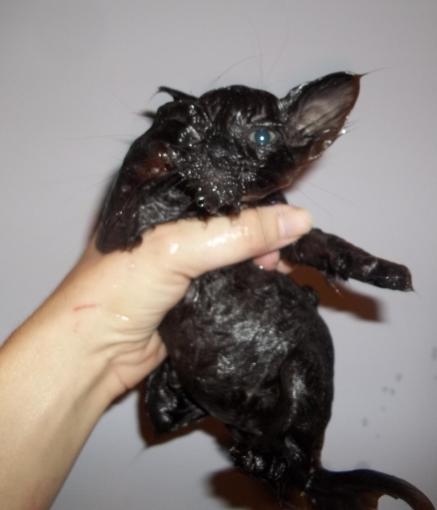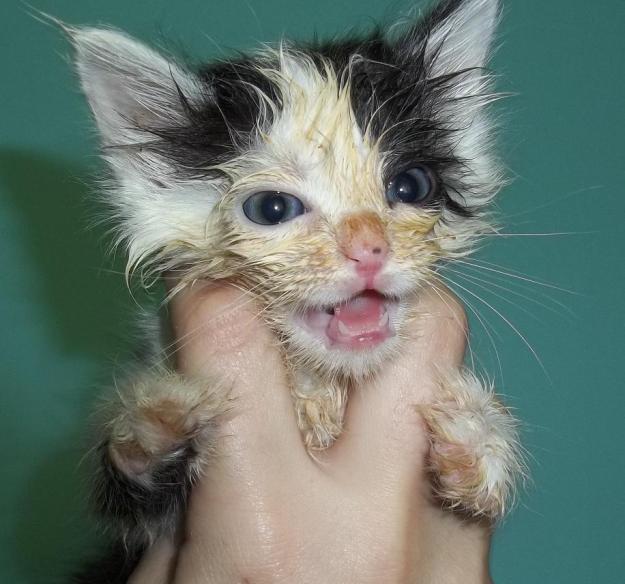*Please do not reuse any pictures without written permission. All images belong to the blogger of alabamatable.wordpress.com.
Since my early teen years, I’ve enjoyed working in animal rescue. Beginning with walking dogs and entertaining cats while sharing the nitty gritty cleaning duties, I’ve now done it all! Medicating, adoptions, running an adoption center, coordinating volunteers, handling paperwork, organizing or running fundraisers, handling social media sites, handling interviews, fostering, etc. There’s nothing that will keep me from supporting no-kill and all-volunteer animal rescue!

“I want my bottle!” (FYI: this kitten is app. 3 weeks old, with mostly protruding baby teeth, open triangle-shaped ears and wide open eyes)
I love dogs, but most of my time has been spent working with cats and kittens. I do not claim to be an expert, but I know I was “trained” by experts and bona fide crazy cat ladies! We know we can’t save them all, but we’ll always try to save every single one that crosses our path! So when it came to the more critical care, I eventually stepped in and received a crash course that over the years became an in-depth look at how to properly care for newborn and extremely tiny kittens that are too little to wean.
We constantly have requests for training sessions and crash courses for those who’d like to get involved with us or just to save a little kitten they’ve found. Once abandoned, newborn kittens will solely depend on anyone who intervenes to keep them alive. So many things can go wrong, no matter what we do. But if we can save just one life, our efforts are worth it! Here are helpful tips that I truly hope will be useful to someone who’d like to become an animal rescuer!
1. Immediate Care: What to do First
“I found a tiny kitten that couldn’t possibly be old enough to eat wet (canned) paté food yet. What do I do?”
At first glance, try to determine the age. If a veterinary clinic or shelter/rescue group is not an option immediately, here are some tips that will help determine an approximate age:
- a newborn kitten doesn’t lose the umbilical stump until a few days after birth.
- a kitten’s eyes won’t open until 1 1/2 to 2 weeks of age.
- a kitten’s ears will be closed into a small “C” shape until about 2 weeks of age.
- a kitten’s baby teeth won’t cut into the gum line and bud until about 2 weeks of age – sometimes sooner, sometimes later.
Judging by size and those little details, you should have a pretty good age estimation.
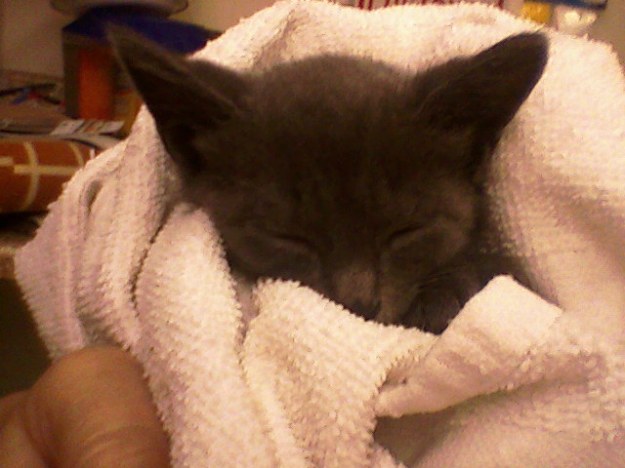
“Bundle me up to keep me warm, and I’ll purr and cuddle!” (FYI, this kitten is app. 3 1/2 weeks old)
First things first: get that baby warm! No matter the temperature outside, the kitten needs to be warm and comfortable. Did you know a kitten cannot create its own body heat or regulate its own body temperature for app. the first month of life? Nope! They rely on their mothers to keep them warm. Without a mother, they rely on you! A towel, blanket or even your own body heat (you can hold them to your chest or close to your neck) will do for starters, but they need to be indoors in a comfortable, enclosed room quickly.
The great indoor/outdoor debate for cat ownership is best reserved for the topic of adult cats, but not for kittens. Please do the reasonable, educated thing and never let a kitten outside. They are not dogs. They will not “be trained to never go far,” nor can you ever reasonably expect any animal to always stay close or safely return home. They ultimately depend on you to set barriers and provide their security. You will be doing absolutely nothing but posing health and safety risks. Vitamins from the sun? Sunlight comes in through windows just fine. Exercise? Play with the kitten! Fresh air? Outside air isn’t healthier than a home’s central air system. Not everyone lives within range of the crisp, fresh air of the Swiss Alps. Not everyone has honest neighbors with BB gun-less kids. Not everyone drives 5 mph to ensure they never hit an animal. Not everyone has an alarm that can detect when a predatory animal draws near their home or when something poisonous looks tasty to a pet. These are all extremely common problems for pet owners, not over-the-top scenarios. Please keep kittens safe, warm and parasite-free indoors. Don’t risk their health and safety because you’re too proud to change your opinions or habits – kittens solely depend on you to survive. If this basic need of staying indoors can’t be met, please consider relocating the kitten to a new foster home.
Blankets are nice for bedding in a crate or box, but heating pads are better! I highly recommend a SnuggleSafe Heating Pad underneath a towel or blanket. I do not recommend electric blankets for animals. Anything electrical is a bit dangerous for animals, and the blankets can get too hot for kittens. Covered plastic heating pads like SnuffleSafe discs for animals are perfect – they’re safe, have no electrical components, are extremely durable, maintain a constant temperature for about 10 hours, and only require a few minutes in the microwave to activate!
A second step that is extremely important to any animal is to address a flea situation. Newborn kittens are so tiny that fleas can quickly drain them to the point of no return. 😦 No matter the severity, NEVER use any flea shampoo on a kitten under 10-12 weeks of age! Just like human babies, a kitten’s skin is extremely sensitive. The chemicals found in flea/tick preventative are in flea shampoo, and are intended to enter into the bloodstream after being absorbed through the skin. Flea shampoo will kill newborn kittens. Regular gentle kitten shampoo may still be too abrasive for their skin, and likely won’t kill many fleas. There’s an easy, cheap solution to this situation: Dawn liquid dish soap is gentle enough on their skin but powerful enough to kill most if not all adult fleas.
Use about a dime-sized amount of liquid dish soap to bathe a kitten under 3 weeks of age. Make sure the bath water is lukewarm, matching it close to your body temperature. It needs to be warm for them, not warm for you. It’ll be too hot for them before it’s too hot for you, so be careful!
Try not to bathe kittens more than once or twice the first day to rid them of fleas. Only repeat maybe once a week. Baths are always going to pose the risk of significantly lowering a kitten’s body temperature, so keep it to a minimum. Immediately dry and warm the kitten after getting them wet.
Any pet store and most big box stores’ pet supply sections will carry a fine-toothed flea comb. Please try to run a flea comb through the kitten’s fur as often as possible! Soap will not kill many flea eggs, so the flea problem is likely only temporarily solved. But don’t get too preoccupied with it – we’re just trying to keep him/her alive at this point. The kitten will be old enough for better parasite control solutions soon, but not right now!

Be sure to use a flea comb frequently and even check by hand for fleas/flea dirt often. (FYI, this kitten is app. 3 weeks old)
Around age 4-5 weeks, if fleas are still an issue, please visit a veterinarian to inquire about an extremely small dab of kitten flea/tick preventative and a possible first dose of dewormer. Even if the kitten never had many fleas, they do need a fecal flotation test for parasites and even a preventative dose of dewormer, no matter the test results. Many vet clinics will have a large supply of topical flea/tick preventative they can apply in a safe dose much smaller than anything pre-packaged. It will literally be a dab. But please only let a veterinarian administer the dosage – don’t try it yourself! If you’re worried of the high risks this brings to the kitten (which is perfectly reasonable), feel free to wait until age 8-9 weeks, when the kitten is safely eligible for a first full dose of flea/tick preventative.
2. Feeding
“Now the kitten is warm and has been bathed. How do I feed him/her?”
If the kitten is under 4-5 weeks of age, the BEST option is to find a nursing mother cat who will adopt the kitten. No kitten formula can replace all the nutrients and immunities that a real mother cat’s milk will give them, not to mention the warmth and bonding that an adoptive mother cat will provide. A mother cat is the best chance at an abandoned kitten’s survival.

Foster cat Lula adopted 1-week-old foster kitten Baby Tux. She nursed her, groomed her and kept her warm as if she were her own kitten. Lula’s own kittens were 3 weeks old at time of “adoption.”
Unfortunately, an adoptive mother cat is rarely an option. But we can bottle-feed kittens! This is time-consuming and takes a little know-how, but it can be done. The good news is kittens can be weaned onto mushy canned food around 4 weeks (we’ll talk about that later). Go shopping in a pet supply store for kitten milk replacer formula and small animal nursing bottles with rubber nipples. I rarely see them at Wal-Mart, but it wouldn’t hurt to try your big box store’s pet section (though I wouldn’t trust their brands of formula, such as the infamous and unsafe brand Hartz). You can always order products online, but it doesn’t help when you need these things immediately. Goat’s milk is always a better last-minute option, as well. But NEVER give them cow’s milk or anything processed for human consumption or for older kittens (such as Whiskas cat’s milk – that is a treat developed for adult cats after they surpass kitten age and become extremely lactose intolerant. Whiskas cat’s milk is not a mother cat’s lactating milk)!

Hold kitten belly-down and tip their head back. Hold the bottle higher than their head so it tilts down. Never hold them on their backs while feeding! (FYI, this kitten is approximately 1 week old)
Though many brands of kitten formula are available on the market, the best “bang for your buck” that we recommend is KMR. It literally stands for Kitten Milk Replacer. KMR brand formula comes in pre-liquefied form in cans or in powder form. The powder form will go much further. If you do choose the pre-liquefied canned formula please dilute with water just a tad bit, maybe a teaspoon of water per tablespoon of formula. It’s too thick for kittens to drink, and quite rich. Some kittens will flat out reject the formula straight from the can.
Always heat the formula to a comfortable lukewarm temperature. Shake the bottle well and squeeze a drop or two on your fingertips to test the temperature. Don’t let it be hot to the touch – let it match your body temperature. It should feel “room temp” to your touch, but don’t let it be much warmer than the temperature of the tips of your fingers. It’ll be too hot for a kitten before it’s too hot for you! Formula that isn’t warmed can make a kitten very sick (Colic), so please never skip this step, even if you have to heat it in your hands for a while! Microwaving formula has caused a debate for fear of losing some of the essential nutrients provided in the formula, though there’s no proof this happens in a microwave. Soaking bottles in hot water for app. 5 minutes is also a great option. Some “crazy cat ladies” have been known to stuff a bottle in their bras to use their own body heat, as well! But no matter how you heat the formula for kitten consumption, always refrigerate any leftover or pre-mixed formula until next use.
It’s perfectly normal for a kitten to refuse the formula at first. It does not taste as good as mama’s milk! But they are hungry and will latch on to the bottle eventually. Make sure they eat at least half a tablespoon (or 6-10 mL) the first couple of feeding sessions, even if you must use a syringe to feed them. Not every kitten catches on to the bottle their first try!

A syringe at first is a great helping tool if they reject the bottle, but a small animal nursing bottle is highly recommended. Try the bottle every feeding time until they catch on. (FYI, this kitten is 3 days old)
The proper way (and only way) to safely bottle feed a kitten is to hold the kitten belly-down on a flat surface. Actually, I prefer to place them on my slightly raised knee so their front is slightly raised, much like they would slightly pull their front halves up to raise their heads and nurse on a mother cat. But they will still mimic that position on a flat surface. Just try not to hold them in your arms while bottle feeding (not enough stability). Hold the bottle slightly higher than their heads so the bottle and nipple tilts down towards their mouth. That obviously helps keep the formula flowing, but it also helps recreate the same position they’d nurse with a mother cat.
NEVER feed a kitten on its back! I can’t stress that big no-no enough. So many people do it because they’ll see others do it or want to hold the kitten like a baby doll. But NEVER do it. This will cause aspiration, which will lead to a horrible choking death. You MUST feed them belly-down. Their heads must always be held higher than their bodies so formula essentially goes down their throats in a declining angle.
To entice the kitten to take the tip of the bottle’s nipple, squeeze a little formula into the tip, insert it into the kitten’s mouth and wiggle it around gently. It’s okay to gently squeeze a few drops into the kitten’s mouth so they can taste the formula. Most will bring their little paws up to “grab” the bottle like a little kid! The kitten will naturally try to latch on, but the trick they must master is wrapping their tongues around the bottle’s nipple to suckle. Not every kitten gets it right the first try, and sometimes not on the first day. Sometimes they just chew on it, unlatch, get so darn frustrated and cry about it! Many do that periodically, even after they learn to latch on! But don’t worry yet! A syringe, which can be obtained for free from most friendly vet clinics or animal shelters, can be used at first to gently and slowly force feed formula to the kitten (in the same position as recommended) until they latch on and begin to suckle from the bottle.
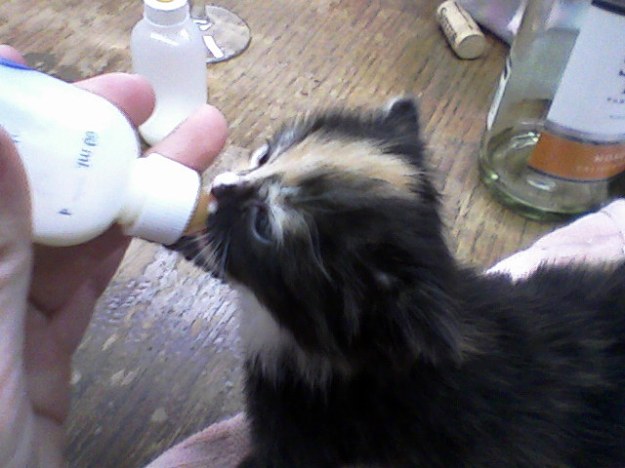
Make their heads lift up to reach the bottle in a natural kitten nursing position. NEVER feed them on their sides or back, always belly-down. (FYI, this kitten is app. 3 weeks old)
“How much should I feed the kitten, and how often?”
Here’s a general by-age guideline per mL intake:
- 1 week and under: kitten should consume at least 1 tablespoon (15 mL) every 2 hours
- 2 weeks: kitten should consume app. 2 tbsps (30 mL) every 2-3 hours
- 3 weeks: kitten should consume app. 3 tbsps (45 mL) every 3 hours
- 4 weeks: kitten should consume app. 4 tbsps (60 mL) every 4 hours
Feeding times can vary, but should be more frequent the younger they are. They’ll want to consume more as they grow older and bigger, so feeding times can be scaled back about an hour or so as their intake increases. Luckily, kittens will sleep for several hours without needing to be fed, so this doesn’t have to be a round-the-clock chore. You can get some rest! To ensure the kitten will sleep in their very warm and cozy confined area (crate, box, etc), cover the crate with a sheet to block out light and to help stifle a little bit of noise. Always make sure it isn’t too big or heavy to affect the amount of fresh air that needs to reach them.
Burping is necessary! After each feeding, place a towel over your shoulder and hold the kitten on your shoulder, much like you would a human baby. Gently tap the kitten’s upper back (between the shoulder blades or a little lower) with a couple of fingers for several minutes at a time, pausing every 30 seconds or so to give the kitten a break from the tapping. The kitten may cry from confusion, but you will definitely hear a little burp (those will get louder as they grow!) after a few tapping sessions! If they don’t burp after several minutes of tapping, that’s okay. They may burp on their own a little later or didn’t need to audibly burp this time.
3. Bowel Movements
“How does a kitten this young use the bathroom?”
Always the most confusing and least favorite part of hand-raising newborn kittens, urinating and defecating requires your manual help. Newborn kittens are used to a mother grooming them and using her tongue (I know, I know, but keep it together – nobody’s saying you have to use your tongue) to stimulate their natural processes to relieve themselves. Good news for you later on down the road is that they will pretty much naturally teach themselves to use litter as early as age 4 or 5 weeks (we’ll get to litter training later). But for now they need gentle stimulation with a cleaning cloth or paper towel to relieve themselves at least every feeding session, maybe a bit more frequently than that.
Using a warm, damp cloth or paper towel, gently and slowly rub the kitten’s genital region until they urinate. Do not mash down, for risk of harm to the kitten or causing a rash or infection. They will not poop every time, but they will urinate frequently. It takes a bit of patience, since it may take a couple of minutes to stimulate the anal glands and encourage them to poop. Gas is a telltale sign they do need to poop. You want to prevent them them from soiling on their towels or bedding. The sanitation issues from being around or wallowing in their own waste should be obvious enough.
This is always the most unpopular chore, but it’s a very important one. For instance, there may be a legitimate medical concern if the poop isn’t regular or very solid by age 3 weeks. If you have any concerns over their bowel movements or for any other reason, please never hesitate to take the kitten to a veterinarian. Hesitating even for a few hours could mean a loss of life!
TIP: If the kitten travels around with you or if you’d just like an easy suggestion for liners, using puppy training pads to line crates or carriers for newborn kittens is a wonderful option. The liners are cheap, soft and disposable!
4. Weaning
“The kitten is between 4 and 5 weeks old now. What next?”
Congratulations! Your kitten’s age is a great age to feel safer about their health. If they’re lively and playful and are developing their bouncy and clumsy motor skills, they’re right on time! They should also have a nice set of baby chompers! Let’s wean them off the bottle and introduce them to canned food!
Some kitten rescuers like to start the pre-weaning process with 2nd Step KMR, a formula powder much like the 1st Step KMR for bottle feeding. But 2nd Step is ideal for kittens to lap up like water. In fact, it can coincide with first water drinking lessons discussed under Dehydration (see part 6: Medical/Critical Care Concerns). We also recommend mixing 2nd Step with canned food, but no earlier than 4 weeks of age.
These babies are new to chewing their food, so chunks of meat are not what kittens should start out on – we don’t want anyone to choke! No flaked or sliced meats – start with paté. Don’t be afraid to make it even mushier with extra smashing and even a little added water or Pedialyte. The can label will state that it’s paté or another consistency. You can find canned food specially formulated for kittens in major brands such as Fancy Feast, but it isn’t necessary.
Around 4 1/2 to 5 weeks of age, a kitten will be ready and eager to try dry kitten food. If your kitten is still pretty small and choking is a worry, try soaking a handful of dry food in water for a minute or so to mush the pellets a good bit, then drain and either leave in pieces or mash into a gruel. But by 5 weeks, the kitten can chew dry food (and everything else in sight!), so don’t be afraid to jump to this last phase of the weaning process. Many veterinarians recommend a kitten to stay on a diet of kitten chow or at least a half-and-half mix until age 7-8 months, but it can be scaled back if your kitten packs on too much weight due to the fatty kitten food.
After the kitten is successfully eating dry kitten food, a healthy dollop of canned food per kitten is still highly recommended every other day. The high water content provides many health benefits, one being the hot button issue with kittens: preventing dehydration.
5. Litter Box Training
“Training” is a term used loosely when discussing a kitten’s natural compulsion to dig, squat and bury their body waste. Most litter contains a chemical attractant (along with silicone dust to give them eye infections! Ugh!) to help encourage litter use. If the kitten doesn’t seem immediately interested in (correctly) using a litter box, a nice “cheater” method would be to save a “sample” from one of their recent potty sessions to plant in the litter box. Their own poop scent as extra attractant is excellent encouragement for a kitten to use the litter box. An older foster kitten or other cat who can lead by example is also a great option! Patience is key. They will want to dig in something to use the bathroom, then cover it up (clumsily – please be patient with this, too), so it will happen!
It’s typically safe to start encouraging litter box use around age 4 weeks, around the time you’re ready to start the weaning process. The starter box should be small and shallow for easy access. Do not put the litter box in the crate or leave out without supervision for the first week or so. A box-flipping or litter-tasting party will take place! Anything you leave out is sure to be played with or destroyed. It’ll look like the cutest little youth riot ever! Since they will put just about anything in their mouths, we always recommend starting out away from clay/based litter and trying a cedar pellet or other organic litter instead, to reduce chances of poisoning or choking on litter. Try a brand like Yesterday’s News. Kittens can be trusted with more conventional clay litter about a week or so later, when they know it’s for pottying and will be less inclined to taste it. Plus, the longer they can stay away from anything remotely dusty when shaken up, the better! Dusty and fragrant litter can result in eye infections or congestion.
6. Medical/Critical Care Concerns
By age 3-4 weeks, kittens can start experimenting with drinking water. Their little smushy faces can make this task difficult! Tiny kittens aren’t very tall, in case you haven’t noticed. They can’t lean or reach like adult cats. Their litheness and grace comes quite a bit later! But until then, these clumsy kids with their lack of motor skills need your help to learn these small and easy tasks. Containers with raised sides will cause kittens to lean over a little too much, which means the angle they’re reaching the water is an unpleasant one – they’ll get water up their nose every time! I always start out with a very shallow saucer, or even a container lid from sour cream or yogurt. They don’t need much, so training on a very little bit of water in a container they’ll be able to use at a safer angle is ideal. I do not recommend leaving any container of water near them when you aren’t watching them. It’s messy! It will be stepped in and spilled. Anyone who tries a larger container also has the risk of a kitten drowning, even in a shallow amount of water. You wouldn’t leave a mop bucket full of water in your baby’s crib, would you?
“Why is water first under critical care?”
Answer: DEHYDRATION.

Baby Stewie is using a shallow saucer to drink water. He doesn’t need to reach over a rim nose-first and instead is able to naturally lap at water. (FYI, this kitten is 3 1/2 weeks old)
Dehydration is the #1 health concern with kittens of any age. Kittens 12 weeks and under are considered in a “critical” health stage due to this risk (among other reasons, such as inconclusive test readings and diseases from lack of vaccinations before 12 weeks). Dehydration should be at the forefront of any kitten rescuer’s mind. You’ll always hear vets tell you your dog or cat needs plenty of fresh, clean drinking water available almost constantly. Water is one critical element every living animal needs to survive. Any baby animal needs much more water intake than an adult animal, including kittens. Kittens can dehydrate in a matter of hours!
Bottle feeding on a good schedule prevents dehydration from becoming an issue while bottle feeding, but they still lose an awful lot of electrolytes so easily. You’ll see the side of a Pedialyte bottle in the above picture. Even when mixing up kitten powder formula, I enjoy partially replacing water with unflavored Pedialyte by (at least half) to further prevent random kitten dehydration. I’ll continue using Pedialyte by pouring maybe a tablespoon’s worth into drinking water for kittens already off the bottle. But kittens don’t need nearly the amount human babies need, so use in moderation!
Infant Gas Drops:
Burping is a necessity after a feeding session, but any kitten that may seem gassy or even colicky can receive an extremely tiny, almost half-drop of infant gas drops. You can find these in any pharmacy’s baby section. Not children’s gas drops, but infant’s gas drops. And not a drop per day, but even smaller than a whole drop. Be careful when giving an animal human medication! If you feel uncertain about this, please consult a veterinarian for advice.
FKS: Fading Kitten Syndrome
It’s my least favorite subject to talk about with kitten fosters, but everyone needs to know about FKS. Many veteran rescuers I’ve spoken with had never heard of Fading Kitten Syndrome before. In a nutshell, FKS is the feline version of SIDS – Sudden Infant Death Syndrome. It isn’t a disease or direct cause of death, but more of a blanket term for unforeseen and unpreventable death in kittens. Mostly caused by unforeseen circumstances such as birth defects or other genetic issues, kittens can become extremely listless and unresponsive at the drop of a hat, even without notice.
Many vets recommend using corn syrup if lethargy occurs – sometimes it can be just a tummy ache or fatigue from an energy crash. A dab of corn syrup on the gums should get their blood sugar up and their energy level to perk back up.
Still, within an hour or so, a kitten’s demeanor and health can take a turn for the worse. In these situations, immediate action must take place. No matter the recommended tricks, the kitten needs immediate emergency vet care, starting with IV fluids. But no matter what tricks even a vet may try with fluids and medicine, we can’t predict what will happen next.
See http://cats.about.com/od/kittencare/g/Fading-Kitten-Syndrome.htm for more information on FKS.
Anything from lack of growth, spina bifida, water on the brain, undetectable heart issues, complications from parasites, any virus or incurable/undetectable disease such as Feline Leukemia or FIP, or even unexplained dehydration with inability or lack of desire to rehydrate can cause a previously thriving kitten’s passing. There is nothing a veterinarian can do, even with all the time in the world to prepare. If you lose a kitten, always remember they never stood a chance without your care, they learned humans are capable of loving them, and they owe their days since being rescued to you.
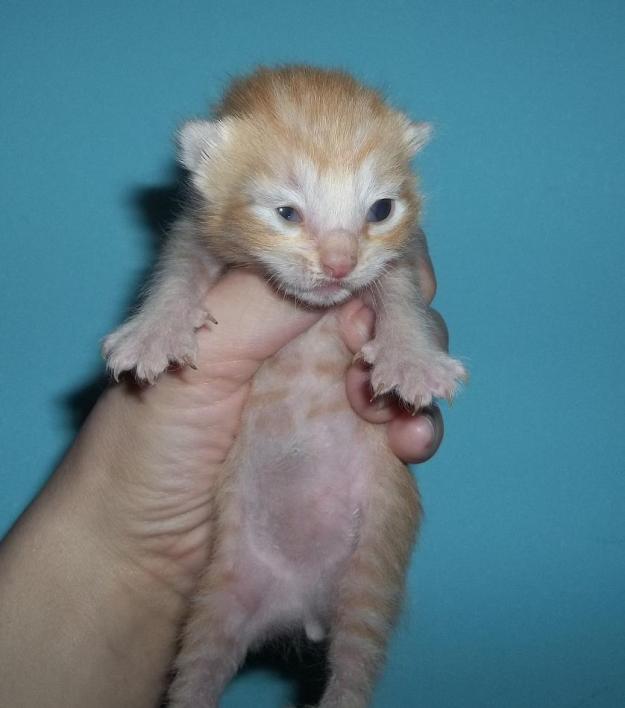
Baby Tyler at 8 days old, his first day of his eyes opening. Tyler stopped growing around this time, made apparent by his littermates’ rapid growth. He succumbed to FKS before age 3 weeks.
Additional tips and tricks are welcome in the comments section! Though the photos are private, these suggestions are very welcome to be printed and shared to further animal rescue and basic care education.
Please contact your local municipal animal shelter or a no-kill animal rescue for information on fostering or volunteering. Many no-kill animal rescues rely on donations, foster homes and volunteers to operate!
http://www.HumaneSocietyofWA.org
*Please do not reuse any pictures without written permission. All images belong to the blogger of alabamatable.wordpress.com.


